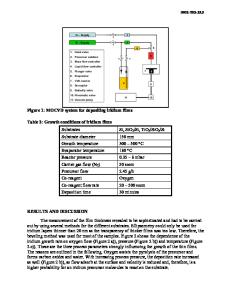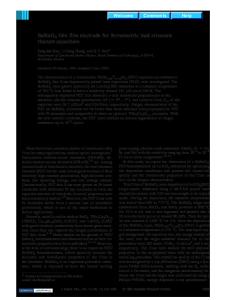Smart electrodes for ultralarge-area thin film capacitors
- PDF / 214,676 Bytes
- 4 Pages / 585 x 783 pts Page_size
- 98 Downloads / 279 Views
Smart electrodes for ultralarge-area thin film capacitors Patrick Daniels and Jon Ihlefeld North Carolina State University, Department of Materials Science and Engineering, Raleigh, North Carolina 27606
William Borland Dupont Electronic Technologies, Research Triangle Park, North Carolina 27709
Jon-Paul Mariaa) North Carolina State University, Department of Materials Science and Engineering, Raleigh, North Carolina 27606 (Received 2 January 2007; accepted 22 February 2007)
A process suitable for preparing metal-insulator-metal thin film capacitors with submicron insulating layers and top electrodes with cm-scale dimensions is presented. Most importantly, this process does not require sophisticated deposition equipment or a clean room environment. The key to large area yield is co-firing the insulator film with a non-dewetting electrode during the dielectric crystallization/densification anneal. We propose a mechanism of electrode dewetting during the high temperature anneal where the metal laterally retreats from geometric asperities that compromise the integrity of the insulating layer. This behavior is driven by surface energy minimization, which promotes metal migration away from the regions of high curvature. This methodology is not material specific, and only requires a top electrode with a large contact angle to the dielectric in question. Using this technique, functional thin film capacitors with 2.5 cm lateral dimensions and 1 m dielectric thicknesses can be routinely prepared.
A “smart” process suitable for preparing metalinsulator-metal thin film capacitors with submicron insulating layers and centimeter-scale lateral dimensions is presented. This provides a revolutionary advance in oxide thin film applicability in implementations where semiconductor process flows are cost-prohibitive. The technique provides a four-order of magnitude improvement in device yield and does not require sophisticated deposition equipment or a clean room environment. The key to improved yield is choosing a metal and oxide combination in which the metal oxide surface energy is greater than the metal-vapor surface energy. If satisfied, partial electrode dewetting during the high temperature anneal naturally coerces electrode metal away from geometric asperities with high curvature. Through-thethickness defects that compromise layer integrity are thereby naturally avoided. This methodology is not material specific and requires only a top electrode with a
a)
Address all correspondence to this author. e-mail: [email protected] DOI: 10.1557/JMR.2007.0272 J. Mater. Res., Vol. 22, No. 7, Jul 2007
http://journals.cambridge.org
Downloaded: 15 Mar 2015
large contact angle to the dielectric in question. These are referred to as “smart electrodes,” given their natural propensity to avoid film flaws. All barium-strontium-titanate (BST) films prepared for this study were deposited by radio frequency (rf) magnetron sputtering from a ceramic target of composition Ba0.8Sr0.2TiO3. In all cases, 18-m-thick copper foil substrates were use
Data Loading...










